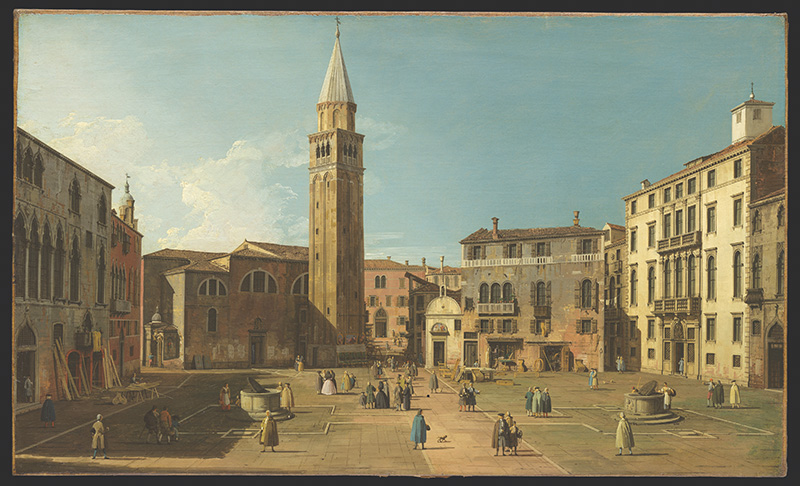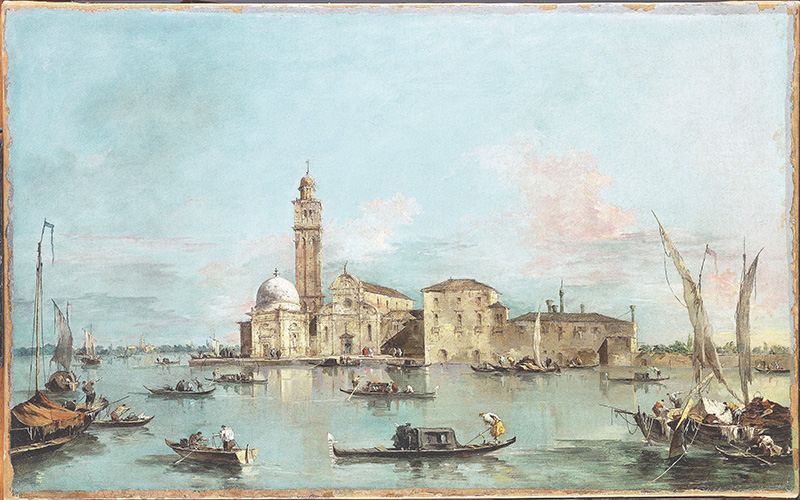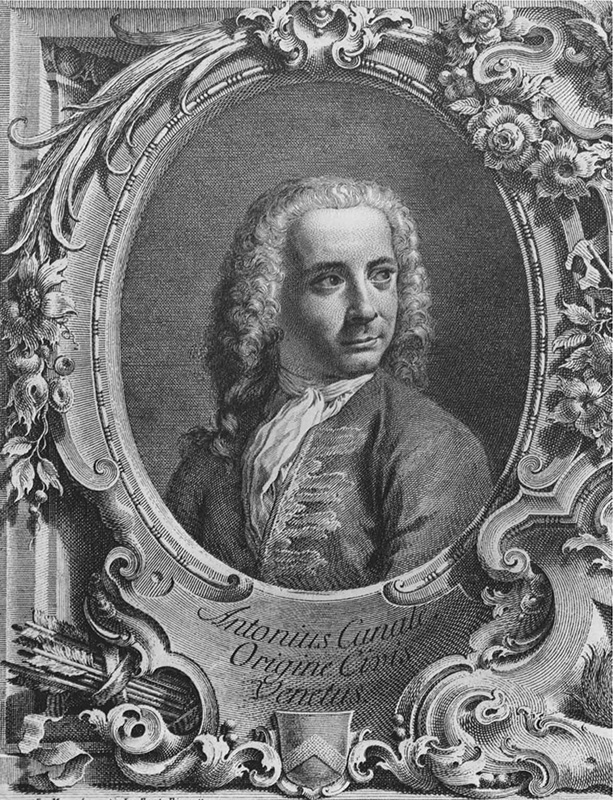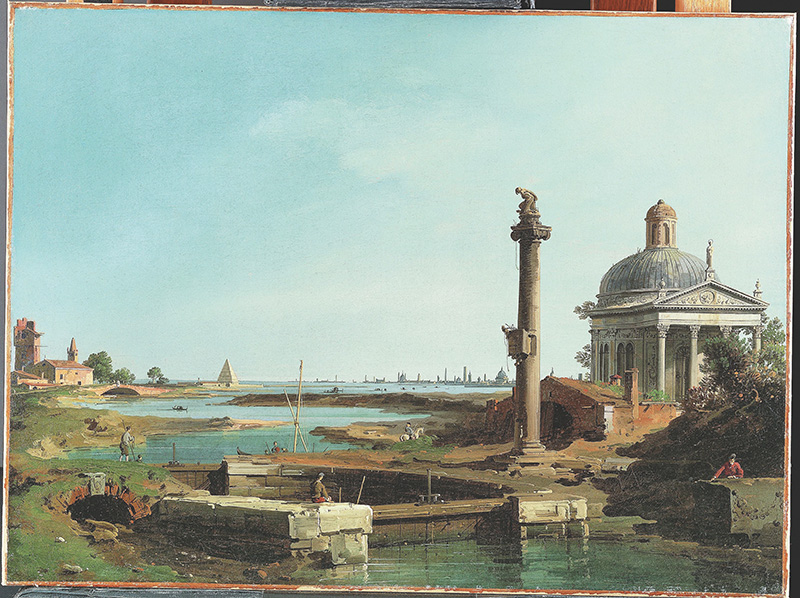
The sage precept of Woody Allen, that showing up is 80 percent of life, is as true of art as of anything else, and perhaps doubly true of the two great scene painters of eighteenth-century Venice, Antonio Canaletto and Francesco Guardi. The British public has a special and long-standing affinity for Canaletto, largely because his works hang so prominently in the National Gallery and the Royal Collection, a consequence of the fact that, going back three hundred years, he has been avidly sought after by British collectors. Indeed, few things feel quite as English as one of Canaletto’s views of the Grand Canal. By the same token, however, Guardi’s works are relatively rare in London and, for that one reason, this gifted rival has never meant nearly as much to the British public.

In France, however, the situation is exactly reversed: despite the Louvre’s three fine Canalettos, it has fourteen Guardis spread out in a single gallery, most of them seized during the revolution from the collection of François-Xavier Depestre (or de Pestre), comte de Seneffe et de Turnhout. And because of this imposing display, Guardi is so familiar to Parisians that he seems fully as French as Canaletto seems British. The case could even be made that, thanks to the Louvre’s prominent display of his thickly impastoed paintings, Guardi played a role in the rise of impressionism.
Although Canaletto, the focus of this article, has his admirers in America, he has never achieved the same status among us as he enjoys in England, not least because of the relative scarcity of his work on this side of the Atlantic. But all of that just changed, now that the Metropolitan Museum of Art has put on view the six Canalettos (together with two Guardis) that it recently received from the estate of Jayne Wrightsman. These paintings, it is true, are on the smaller side, but their extreme excellence and the flawless state of their preservation have transformed the museum, seemingly overnight, into an essential destination for anyone interested in this artist, one of the finest of the eighteenth century.

Let us take a moment to celebrate Mrs. Wrightsman’s generous act, only the latest of many that have enhanced the Met over more than half a century. By the time she died in 2019, in her hundredth year, she and her late husband, Charles, had given a staggering 1,275- plus works of art to the museum, including more than 375 in the present bequest. Each of these gifts revealed a taste of singular refinement and consistency that no amount of money, by itself, could ever buy. No less importantly, her bequest included over $80 million to purchase additional Old Masters, which is in addition to the funds she had already donated during her lifetime. But Mrs. Wrightsman also endowed the European Sculpture and Decorative Arts department—even donating several magnificent period rooms—as well as the Asian and Islamic departments and the museum’s Watson Library. Had she chosen, she could surely have negotiated to keep the entire collection together with her name on it, as was the case with the Met’s Lehman Wing: instead, she selflessly offered it to the institution to display as it saw fit, thus ensuring that few visitors would ever understand the full breadth of her generosity. Max Hollein, the museum’s director, was entirely correct to say that “the Met would not be what it is today without Jayne and Charles Wrightsman.” Before this latest benefaction, the Met owned only one painting by Canaletto, and that, too, had been donated by Mrs. Wrightsman, in 1988.

Despite her wide-ranging interests in the visual arts, Mrs. Wrightsman seems to have had a special love for the eighteenth century and for that grace, polish, and enlightened refinement that figure so prominently in these six works by Canaletto. The oily richness of their pigment is so preternaturally fresh and lustrous that you could well believe that they had never before been exposed to daylight, that they were painted this morning. And it is this quality of the pigment that invites us to reconsider and to challenge certain long-standing notions about the artist.
For many viewers, the most obvious quality of Campo Santa Maria Zobenigo (Fig. 2) or The Grand Canal, Venice, Looking Southeast (Fig. 1) is that they are “photographic,” that they skillfully, if perhaps journalistically, transmit to us the relevant data of the Venetian cityscape. And, indeed, you could easily look south along the Grand Canal, three centuries later, and immediately find your bearings on the basis of Canaletto’s depiction. As for the former painting, the magnificent church in the foreground is still very much there.

In addition to the prodigious clarity of Canaletto’s images, he has a rare ability, shared by the finest photographers, to seize instinctively upon the most telling and essential angle of any urban or architectural context he enters. In his depiction of Campo Sant’Angelo, for example, it might seem as though he simply stood in the middle of the square and painted what he saw (Fig. 3). In fact, the perfect, if asymmetrical, balance between the looming campanile, slightly left of center, and the pale buildings on the right, represents the best use, for his purposes, that an artist could possibly make of the facts on the ground. And the angled perspective of the bell tower, as well as the way in which the sun strikes its western facade, is a masterstroke.
At the same time, Canaletto had a singular gift for detail. Consider, in The Grand Canal, Venice, Looking South toward the Rialto Bridge, the frantic agglomeration of markings that make up the two palazzos on the far left (Fig. 6). Etched in those idiosyncratic black lines that the artist loved and that impart to his paintings the attribute of a great drawing, these details are, we may assume, the irreproachable record of what the eye encountered from the perspective of a gondola floating midway on the waters of the Grand Canal. But they behave differently from the details that we ordinarily encounter in an Old Master painting: the perspective in which we see them is so steep that, despite their astounding accuracy, they provide no knowledge that we could possibly use. Rather, they are a virtuosic, impassioned embrace of realness for its own sake, fully aestheticized but relinquishing nothing of their grip on the observable world.

But even if we acknowledge, as we must, the journalistic accuracy of Canaletto’s paintings, even if we allow that, as a photographer, he is a great photographer, such a reading is almost certain to overlook both the pure artistry and the pure poetry that are the secret of his art. A Lock, a Column, and a Church beside a Lagoon, a capriccio or imaginary landscape, perfectly illustrates both of these qualities (Fig. 7). But for the faintest hint of a cloud, the entire top left quadrant of the painting is a monochromatic field of palest blue, as pure in its way as any commensurate expanse in Malevich or Mondrian. And like those later artists, Canaletto has not simply squeezed out and applied two square feet of pigment: the silken texture of its application, the fact that the entire canvas unfurls like a length of satin, is the prerogative and hallmark of only the rarest of masters.

But there is also a poetic, even a philosophical dimension to this image. The dramatic shadows that haunt the baroque, and that will be summoned anew amid the Sturm und Drang of the romantic movement, have been thoroughly banished from the sun-filled vistas of Canaletto’s art, as from so much of the culture of the Enlightenment. As one looks out beyond the shallows in the foreground, past the marble pyramid in the offing to the domes and campaniles in the distance, a sense of serenity, of happiness, suffuses the viewer. For Canaletto, this happiness—this “Eternal sunshine of the spotless mind,” as Alexander Pope, his contemporary, called it—stands, in spite of everything, at the heart of the world. And speaking only for myself, I am unaware of any painting able to engender or convey that sense of happiness more effectively than this one.

This story has been updated to correct a description of Fig. 2
